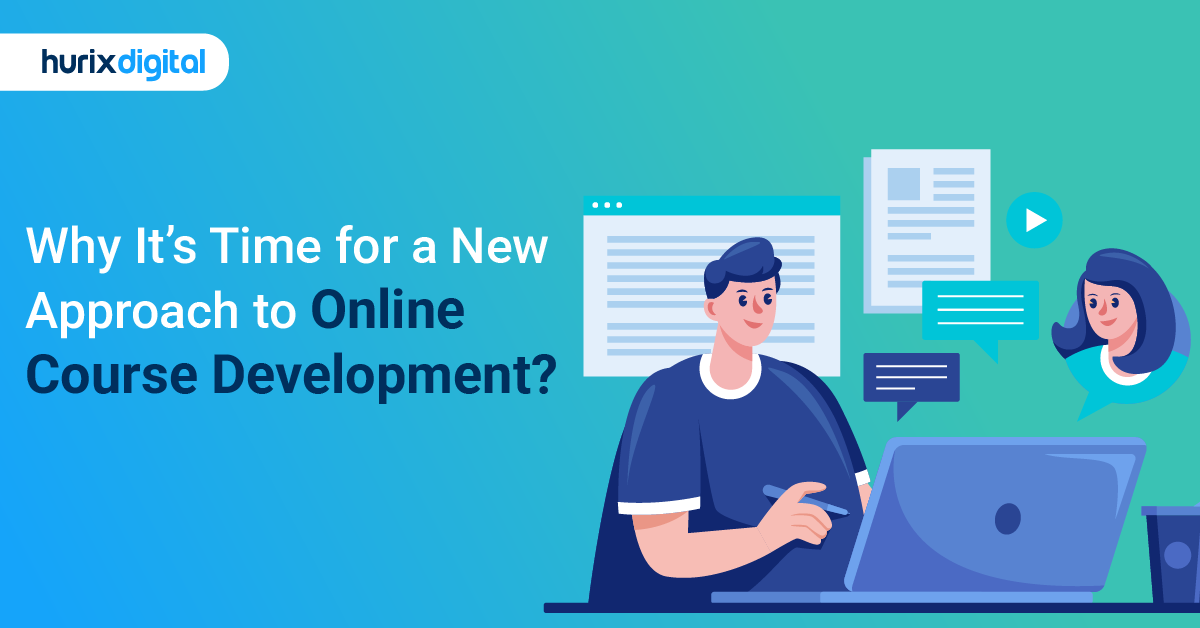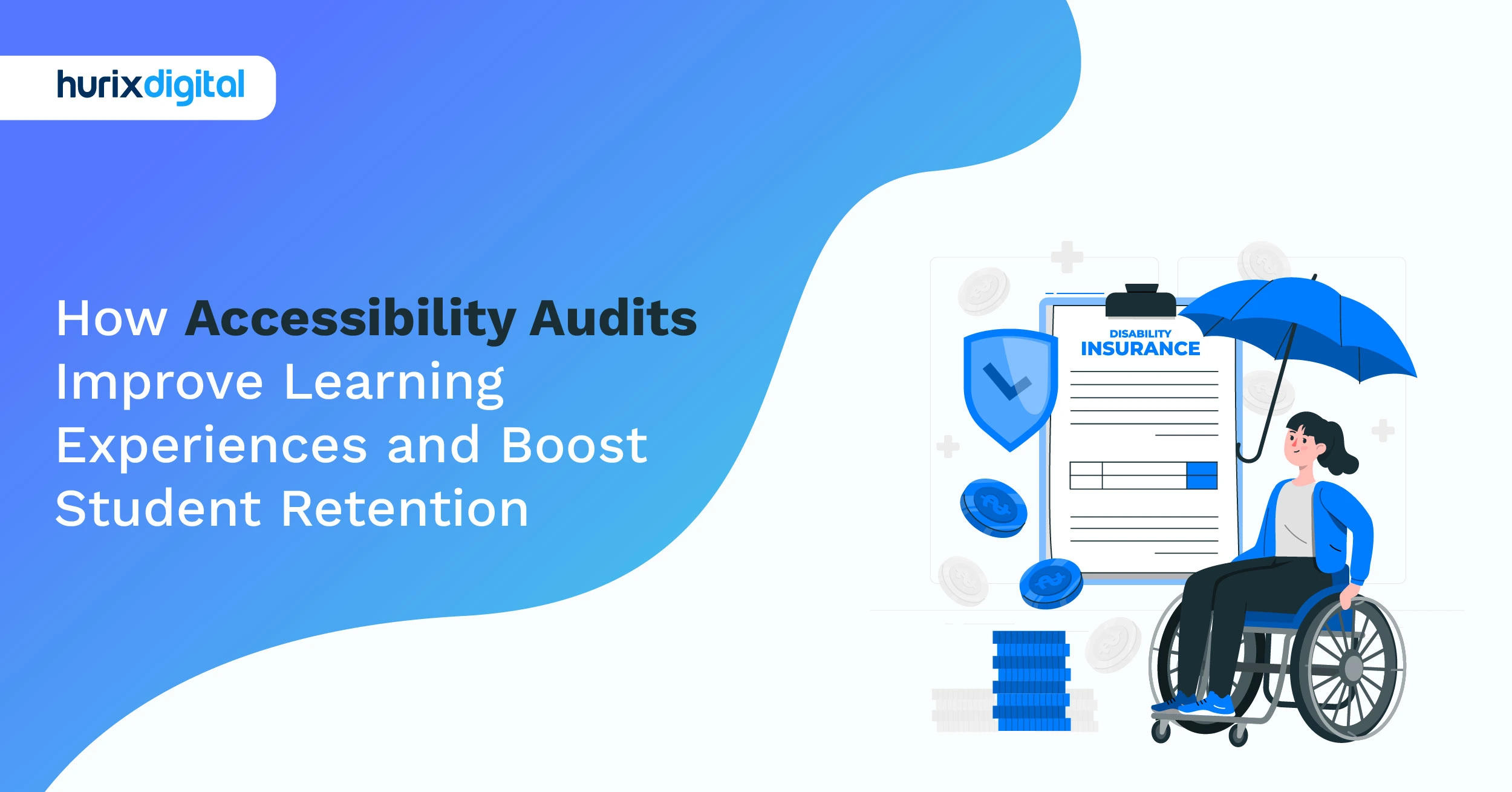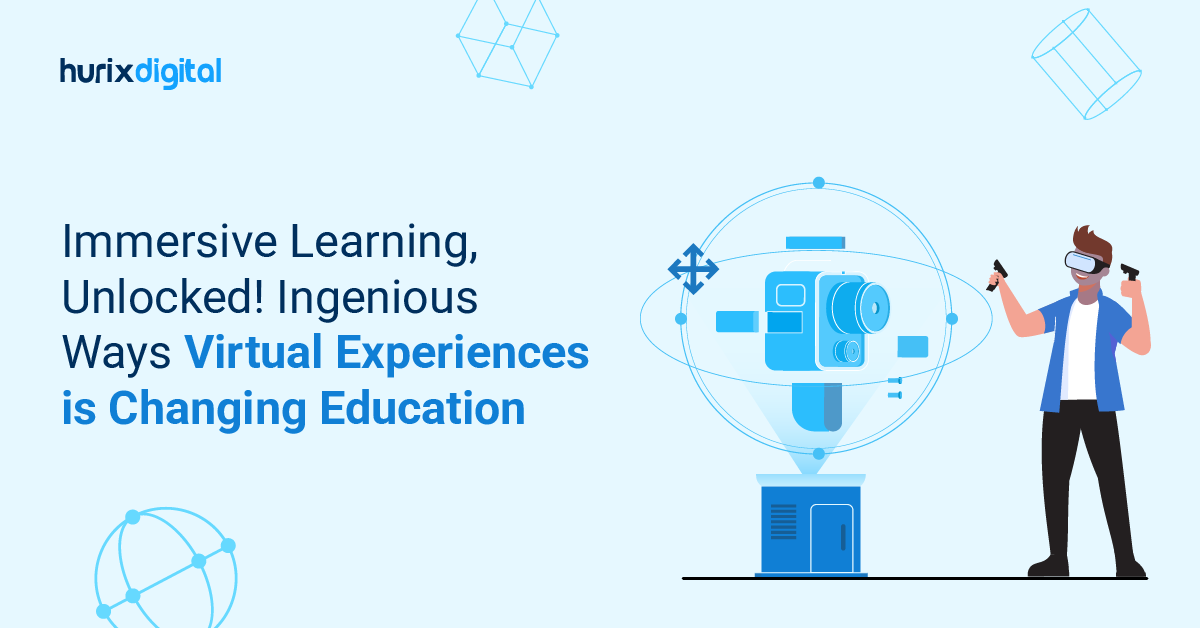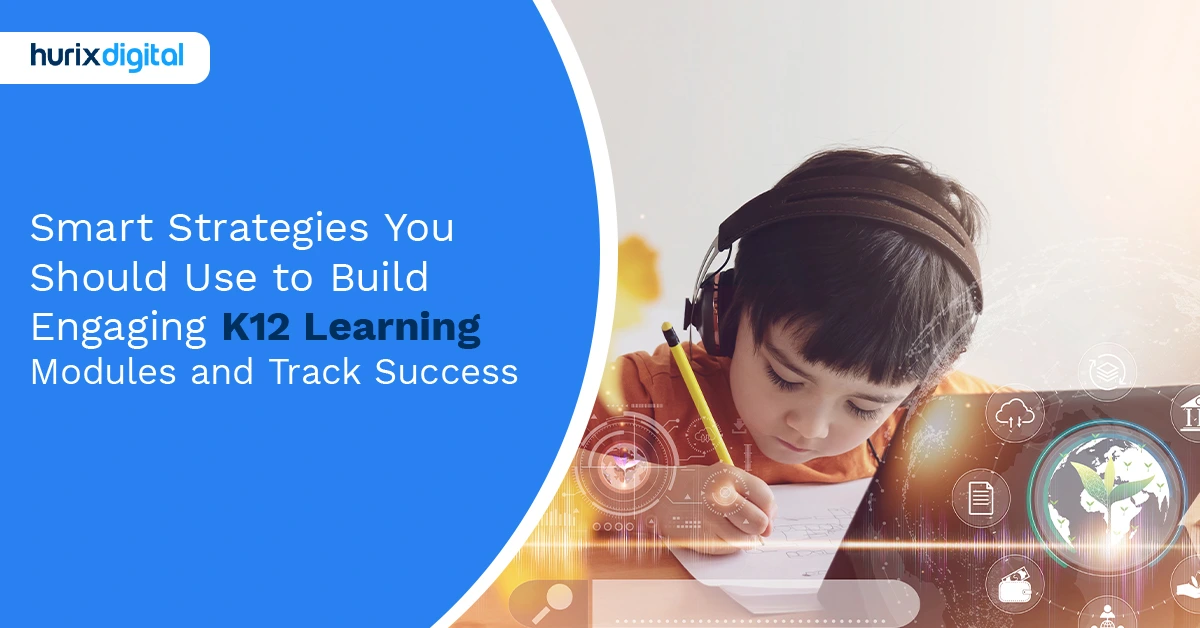
Smart Strategies You SHOULD Use to Build Engaging K12 Learning Modules and Track Success
Summarize with:
With evolving technology in K12 education, eLearning for K12 students has ushered in an era of interactive educational content and immersive educational modules that are keeping students captivated. This revolution is shaking up the K12 curriculum development process as the focus shifts from textbook-based learning to vivacious multimedia learning modules.
According to a recent Gartner study, global Edtech spending related to K12 education is predicted to reach $404B by 2025, suggesting a rapid adoption of digital tools in education. This shows that digital tools in education are becoming popular, especially because today’s students are used to using digital technology.
This blog outlines various tips and tricks for measuring the performance of K12 learning to boost student engagement and productivity.
Table of Contents:
- What are K12 eLearning Platforms?
- Tips to Assess the Rate of Student Engagement in K12 eLearning Platforms
- Top 9 Steps to Creating Interactive Educational Modules for Students
- How to Boost K12 Digital Classroom Success?
- Takeaway
What are K12 eLearning Platforms?
K12 eLearning platforms are an extensive set of interactive digital services that offer knowledge, instruments, and assistance to educators, trainees, and other stakeholders to help them manage and execute better learning outcomes.
K12 learning solutions are materials designed for elementary through grade 12. In the digital age, K12 educational options typically include online resources frequently used to enhance in-person instruction.
Online learning resources for grades K12 possess multiple advantages. Some of these are:
- Audio and video resources are added to text comprehension to enhance the learning experience and pique students’ interests.
- These courses could be simulations with incorporated learning objectives, with stages and difficulties.
Additionally, teachers benefit from the K12 eLearning best practices because they don’t have to spend all their time designing instructional resources. Doing so allows more time to provide each student with a more individualized focus.
Additionally, these systems give teachers access to online tracking, evaluation, and interactive instructional resources.
Tips to Assess the Rate of Student Engagement in K12 eLearning Platforms
The term “student engagement” describes how motivated, interested, and involved students are in the subject matter, as well as how they communicate with the teacher, other peers, and the material. Student engagement is critical to measuring eLearning success because it has an impact on retention, fulfillment, and proficiency.
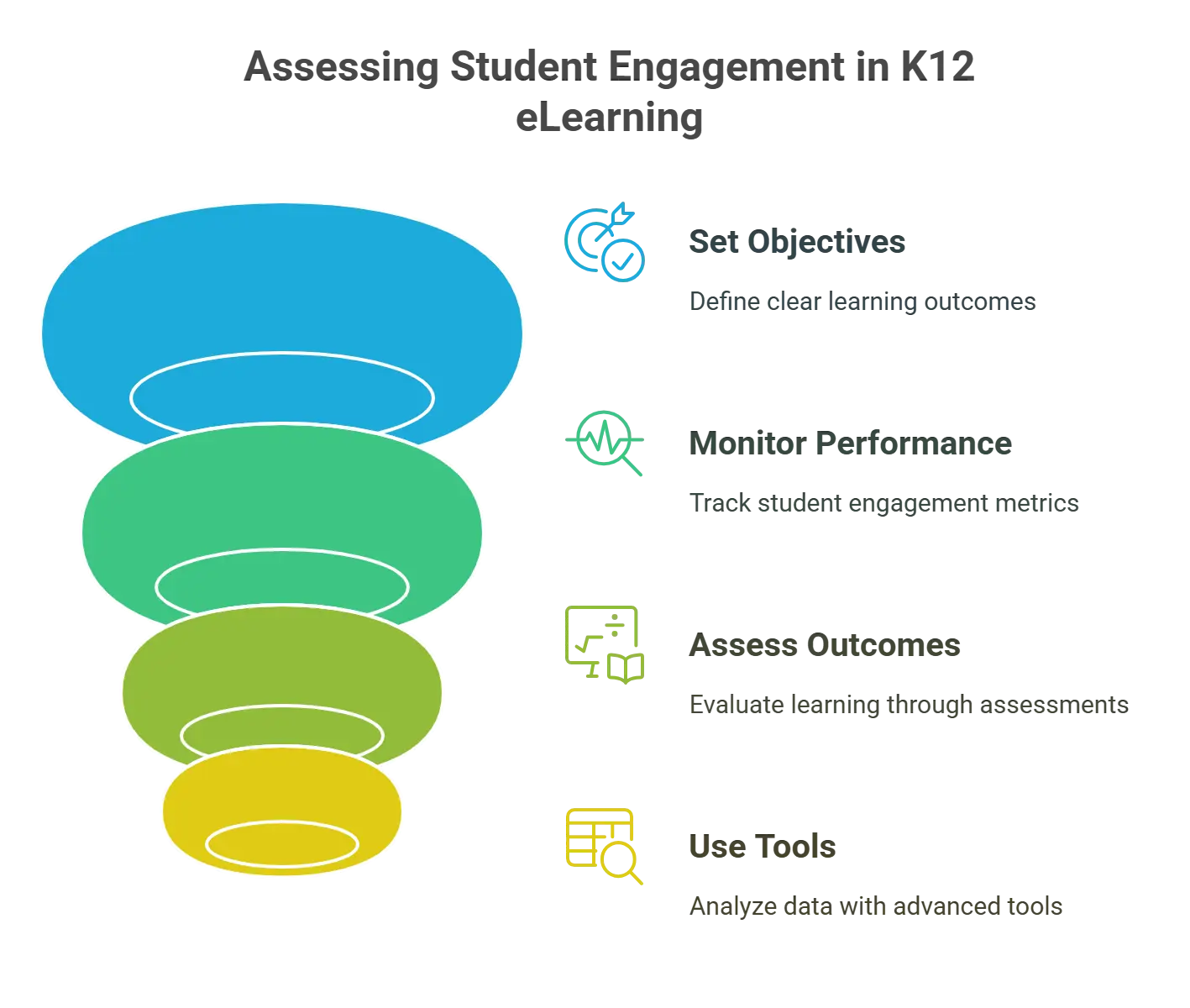
Here are the effective tips you can use for assessing student engagement in K12 eLearning platforms:
1. Set Well-Defined Objectives of Study
Determining and coordinating the course learning objectives with the students’ requirements and curriculum guidelines is one of the initial steps in assessing the effectiveness of online education for K12. Learning objectives are the precise and quantifiable results that learners are expected to attain by the conclusion of the course.
These objectives should direct the creation and dissemination of the course material, tasks, and assessments. They should also be specific, pertinent, and easy to acquire.
Setting out specific learning goals can help you assess whether the curriculum fulfills the standards and prerequisites of the topic and level of study, as well as whether learners are progressing and acquiring the skills and expertise.
2. Monitor Student Performance through Varied Metrics
You can employ a variety of metrics, including duration of the course, degree of completion, feedback, involvement, and participation, to gauge student engagement. To find out how the students feel regarding the course, you may additionally utilize discussions, polls, questionnaires, and assessments.
Metrics such as submission rates, hours spent on assignments, finished modules, login frequency, and grades can provide us with a general idea of how engaged a learner is with K12 eLearning platforms. But keep in mind that when analyzing these metrics, the human element cannot be overlooked.
3. Gauge the Learning Outcomes through Standard Assessments
Learning outcomes, which arise from the educational goals, are the discernible and established outcomes that demonstrate what the students have comprehended and can accomplish after the course. They must also be consistent with the assessment techniques and standards.
A variety of assessments can be in the form of formative, summative, performance-driven, and portfolio-based ones. These assessments are:
- Diagnostic Assessment: There are diagnostic tests at the start of the curriculum. Their purpose is to determine the student’s level of expertise so the teacher can assign them to the most appropriate learning trajectory.
- Formative Assessment: Formative evaluations track students’ knowledge and development over an online program or the academic year. Providing thorough feedback to students following a formative assessment is crucial to assisting them in identifying their areas of potential and limitations.
- Summative Assessment: Summative evaluations of pupil achievement are given at the middle and end of terms. Students receive a grade determined by how well they perform, which is evaluated according to predetermined standards.
4. Use Effective and Advanced Tools
You must gather and combine data from several sources, including the learning management system (LMS), the web data analysis tool, and the evaluation tool, to calculate engagement metrics.
In addition to making sure you have the required authorizations and legal safeguards in place to use the data, you should also make sure it is unbiased, precise, and accurate. To make data organization and analysis easier, you must additionally employ standard protocols and formats.
After comparing the data to your requirements and goals, you should find gaps and areas that could improve. Additionally, you should share the outcomes with the stakeholders and students and offer them suggestions and practical insights.
Top 9 Steps to Creating Interactive Educational Modules for Students
Building innovative and K12 learning experiences has become the utmost priority in the education sector.

When it comes to leveraging technology in K12 education or integrating gamification in education, several steps can be followed to create interactive educational modules for students. Here are the top 9 steps:
1. Identify Desired Learning Outcomes
For a successful K12 learning module, you must commence by identifying your desired learning outcomes. Decipher what you aim for your students to assimilate and establish clarity on the objectives.
A student-centered module should have outcomes that reflect the skills and knowledge the students should acquire upon completion. This step entails scrutinizing the K12 curriculum development requirements and aligning them with the learning goals.
Creating measurable and achievable outcomes will pave the way toward an effective, engaging, and interactive online education for K12 students. Remember that these outcomes serve as the roadmap enabling you to design learning activities, assessments, and tools that are directly linked to the desired learning results.
2. Choose the Right Digital Tools
The right digital tools play a crucial role in creating engaging and effective K12 learning modules. Whether you’re using online teaching methods or implementing the latest technology in K12 education, these tools are a must:
- Learning Management Systems (LMS): Utilize platforms like Canvas or Blackboard to organize and deliver educational resources effectively.
- eLearning Authoring Tools: Leverage applications such as Articulate Storyline or Adobe Captivate to generate interactive educational content and multimedia learning modules.
- Gamification Platforms: Use platforms like Kahoot! or Classcraft to bolster engagement and knowledge absorption through gamified learning experiences.
Ultimately, the selected tools should cater to developing effective, student-centered modules in the K12 curriculum cycle.
3. Design Interactive Content
In the realm of K12 learning, designing interactive educational content is a crucial step. Here are key points to consider:
- Customize according to student preferences.
- Embed quizzes and puzzles to encourage student interaction.
- Use multimedia, such as videos, infographics, and GIFs, to foster interest.
- Implement gamification techniques to enhance student engagement, as gamification in education is a successful approach.
eLearning for K12 students should be enjoyable and educational, and incorporating these elements into content design can significantly enhance the student experience.
4. Integrate Gamification Elements
Gamification in education is the next exciting step in K12 learning. It involves integrating game elements into lessons to motivate and engage students. According to IntechOpen, educational institutions will implement gamification strategies as they benefit students’ learning in the long run.
Building elements like points, leaderboards, and challenges can make learning more appealing. Tools like Hurix Digital are excellent examples of gamification platforms designed for online education for K12. Remember, the goal of gamification is not to make schoolwork feel like a game but to combine the benefits of games and education.
5. Implement Feedback Mechanisms
A research report published in ScienceDirect reported that timely eLearning feedback has been shown to improve student performance by 90%. This shows the importance of incorporating effective feedback mechanisms in educational modules.
Implementing instant feedback in multimedia learning modules encourages student participation and increases their understanding of the subject. Feedback mechanisms can range from quizzes and peer reviews to AI-powered auto-feedback systems.
6. Develop Personalized Learning Paths
Creating personalized learning paths can revolutionize K12 learning.
Here’s how to make it possible:
- Consistent evaluations and quizzes can reveal students’ individual strengths and weaknesses, providing insights to shape a unique learning path.
- Integrate AI and machine learning technologies to make K12 curriculum development more adaptive and dynamic, tailoring it to the student’s learning style.
- Include a variety of online teaching methods such as video tutorials, interactive simulations, and problem-solving exercises.
- Enable regular feedback for continual improvement in student-centered modules. A resource by the Department of Education can guide you on how to do this.
7. Foster Collaborative Learning
Following collaborative learning methods is a critical step in K12 learning. Collaborative learning involves grouping students and encouraging them to work together to accomplish a shared goal.
This might involve problem-solving tasks, group projects, or discussion forums. Research from Forbes suggests that collaboration can lead to better learning outcomes. Furthermore, it helps to develop critical social and interpersonal skills essential for success in the modern world.
8. Ensure Accessibility and Inclusivity
Effective K12 curriculum development ensures full inclusion via accessible programs. Follow these steps to accomplish this:
- Employ special needs technologies such as speech-to-text and text-to-speech tools. This initiative is part of a broader movement to integrate technology in K12 education.
- Ensure appropriate representation of diverse characters in multimedia learning modules to respect all ethnicities, races, and genders.
- Adapt content to accommodate a range of learning styles, ensuring the delivery of truly student-centered modules.
9. Evaluate and Update the Modules
For a successful K12 learning experience, regular evaluation and updates to your interactive educational content are imperative.
Here are a few strategies:
- Use Data Analytics: Most online education for K12 platforms provide useful analytics. You can use these insights to understand how students interact with each module and make necessary changes.
- Keep it Fresh: Regularly update your content to include relevant examples and up-to-date information.
- Collect Student Feedback: Regularly ask your students for feedback about the K12 curriculum development. It’s a great way to uncover any areas of improvement.
- Stay Updated with Educational Trends: Websites like Forbes and Education Week publish the latest trends and studies in technology in K12 education. Make sure you stay informed about the latest developments to integrate cutting-edge educational practices into your modules.
How to Boost K12 Digital Classroom Success?
Student engagement strategies imply how engaged, focused, and interested students are in the learning process. Monitoring certain factors provides insightful information that can be utilized to improve learning outcomes, modify the course material, and adapt teaching strategies.
The following are some useful tactics to enhance students’ participation in online learning:
- Make the eLearning content interactive and captivating by including engaging quizzes, animations, and video content.
- Make the educational process unique and personalized to cater to the demands of varied students by using interactive eLearning tools. Permit students to tailor their educational journey according to their inclinations and passions.
- Offer a range of auxiliary materials. Provide students with online discussion boards, supportive peer groups, and tutoring when required.
- Gamification in eLearning can make learning enjoyable and interesting. To motivate students, you can use leaderboards, points, and badges.
- Summative and formative evaluations should be used to track growth and accomplishment and give prompt feedback.
- In addition to seeking recognition from outside sources and reviewing and improving course design and delivery, using a recognized quality assurance structure or model can be beneficial.
- Identifying shortcomings and strengths can be aided by data-driven choices, and intuitive, reliable online platforms and tools can be employed.
Takeaway
The assessment of eLearning program effectiveness is a continuous process aimed at achieving perfection in the constantly evolving field of K12 learning platforms. These excellent practices guarantee the accomplishment of learning goals, student participation, and ongoing development.
To modify programs and enhance learning, pupils must discover novel possibilities for development, which is why eLearning functions best when continuously assessed.
If you are looking for more evaluative tools and EdTech solutions, Hurix Digital is your perfect partner! Thanks to our innovative approach to instructional design, we create custom content that meets your educational objectives and boosts student achievement.
Get in touch with us to know more!
Summarize with:

Senior Vice President – Business Development
at Hurix Digital, with over 25 years of experience in EdTech and workforce learning. He excels in business development, customer relationship management, and scaling digital learning solutions, driving global growth through innovative content, simulations, and AI‑driven training offerings
 Upcoming Masterclass | Build an Army of Brand Evangelists using Training & Development | November 20th, 8:30 AM PDT | 11:30 AM EDT | 10:00 PM IST
Upcoming Masterclass | Build an Army of Brand Evangelists using Training & Development | November 20th, 8:30 AM PDT | 11:30 AM EDT | 10:00 PM IST


